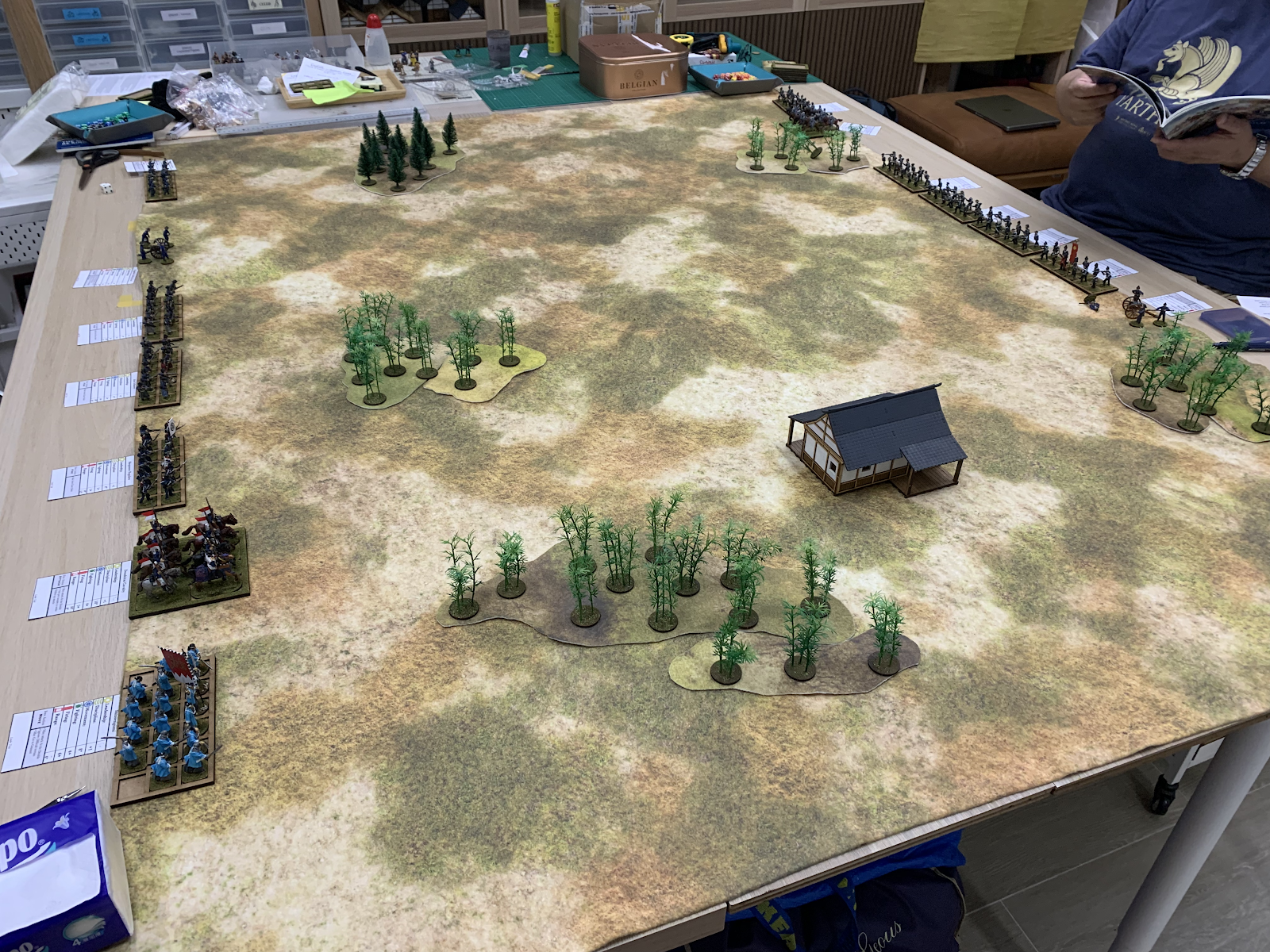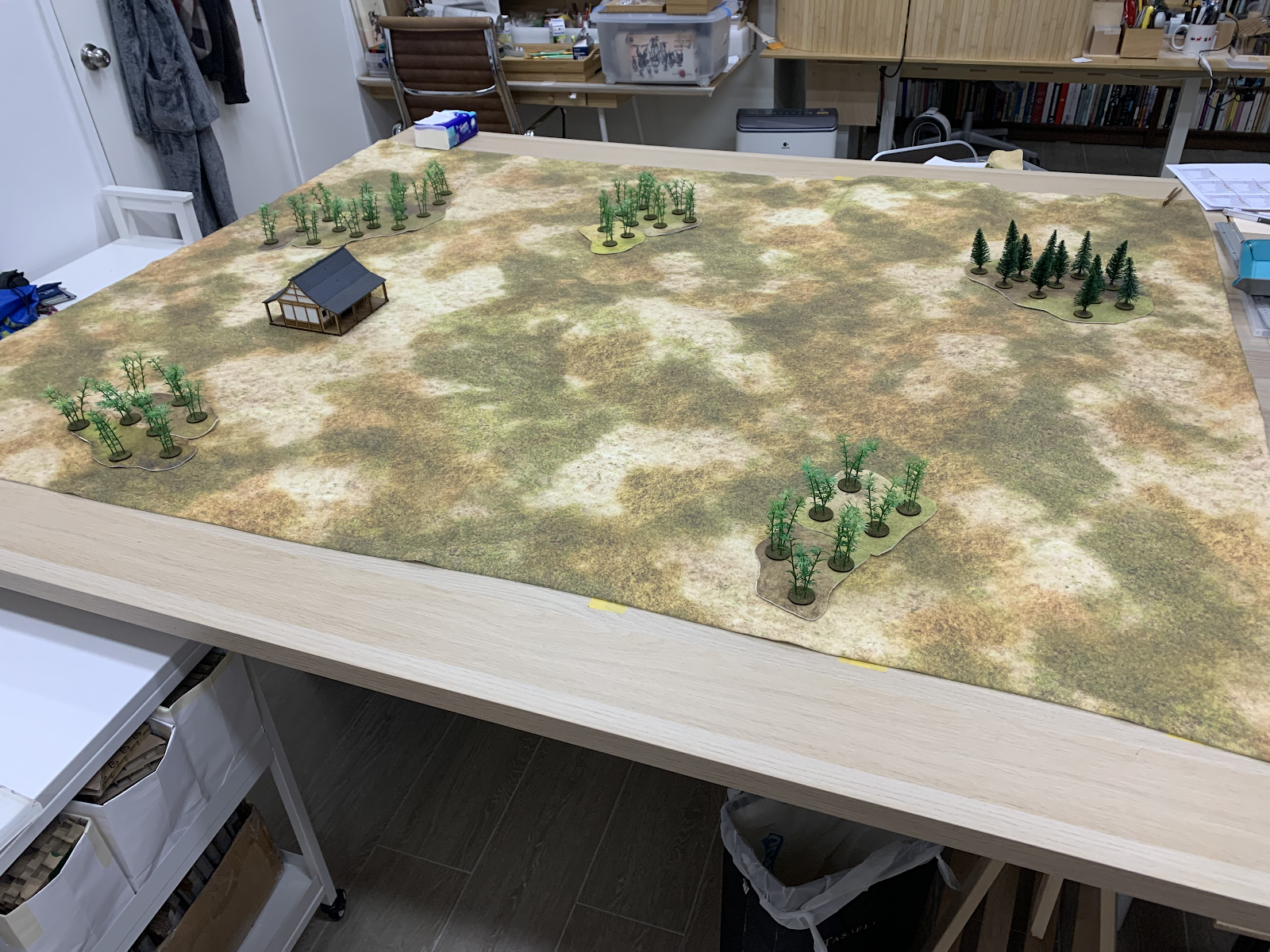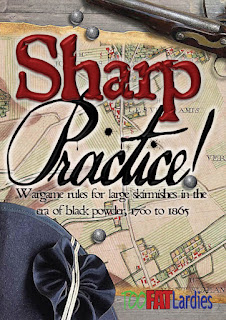The Men Who Would Be Wielders of Great Influence Under A Future Constitutional Monarchy: A TMWBBK AAR
All right, I admit that this is not the punchiest of titles; I'll need to work something out for when I do come up with a more formal Bakumatsu adaptation of TMWWBK. But anyway, following on from the last Boshin War game, this evening it was different armies, different rules, and a different opponent. I had thought I might have played Kings with James once a few months ago, but clearly I remembered wrong, so this would be his first go. It's certainly been an interesting experience: James has been trying to get me into Clash of Katanas for a while, a set of rules I have to admit I am not fully convinced by, and it seems at the moment that the reverse is also true!
With that out of the way, forces: while this was an introductory game, the idea was to get a handle on the various units and core mechanics, so instead of a 24-point scenario game I set up a 36-point battle, with each side having infantry, cavalry, and artillery.
James had some understandable trepidation about the IGOUGO format of the rules, but if nothing else, letting me go first meant that the activation system and the use of the At the Double action could be demonstrated. I hadn't set any specific objectives; the idea basically was simply that we'd go at each other so that he'd see how movement, combat, and Pinning worked.
Things started turning round again for a bit as the Shogunate forces started taking their own, quite heavy losses after that initial assault, and most of the army had rushed out ahead of the main body of infantry.
The back half of the game saw the Shogunate army reconsolidate behind the hills and shift to the left to try to exploit a gap on the Imperial right flank.
Not the longest or most exciting of reports, but Kings tends to play both quickly and predictably, especially without the framework of a scenario, and I also forgot to take photos for most of the middle third of the game so there wasn't a whole lot to show for it, visually speaking.
In advance of him turning up, I took a bit of a novel approach to terrain generation, which I have humbly dubbed 'lobbing dice at the table and seeing what happens'. Wherever a die landed would mark the rough centre of a terrain piece, with 1 being a miscellaneous feature like a pond, 2 or 3 being a wood, 4 or 5 a hill, and 6 a building.
With that out of the way, forces: while this was an introductory game, the idea was to get a handle on the various units and core mechanics, so instead of a 24-point scenario game I set up a 36-point battle, with each side having infantry, cavalry, and artillery.
Imperial:
- 2 Unmodified Regular Infantry
- 3 Poorly-Armed Regular Infantry
- 1 Veteran Irregular Cavalry
- 1 Poorly-Drilled Field Gun
Shogunate:
- 1 Unmodified Regular Infantry
- 2 Poorly-Armed Regular Infantry
- 1 Irregular Infantry with Fieldcraft
- 1 Regular Cavalry
- 1 Fierce Veteran Tribal Infantry (Shinsengumi)
- 1 Poorly-Drilled Machine Gun
On Leadership rolls, we both got decently lucky and had 6+ for everyone, except for my cavalry and Shinsengumi who got 5+.
We opted not to go for traits given this was a first game, and James took the more 'conventional' Imperial force while I took the more heterogeneous Shogunate army.
 |
| Initial Dispositions |
James had some understandable trepidation about the IGOUGO format of the rules, but if nothing else, letting me go first meant that the activation system and the use of the At the Double action could be demonstrated. I hadn't set any specific objectives; the idea basically was simply that we'd go at each other so that he'd see how movement, combat, and Pinning worked.
Because of this, he took an initially aggressive approach, which led to a rather unfortunate couple of reverses as his cavalry on the right got shot up while his infantry on the left were mauled by Shogunate shock troops.
Things started turning round again for a bit as the Shogunate forces started taking their own, quite heavy losses after that initial assault, and most of the army had rushed out ahead of the main body of infantry.
The back half of the game saw the Shogunate army reconsolidate behind the hills and shift to the left to try to exploit a gap on the Imperial right flank.
After failing to activate his artillery or to unpin his beleaguered infantry on the far right, James decided to cede the field.
Not the longest or most exciting of reports, but Kings tends to play both quickly and predictably, especially without the framework of a scenario, and I also forgot to take photos for most of the middle third of the game so there wasn't a whole lot to show for it, visually speaking.
As primarily a rules test, I was curious about James' thoughts, and given his existing like of Chain of Command and Clash of Katanas, I wasn't too surprised to hear him say that he thought Kings was just a bit too simple. More specifically, he made a number of points, all of which I am either sympathetic to or agree with outright:
- IGOUGO is a bit of a simplistic system that also massively discourages either side from being the first to move into range.
- From my experience I've definitely found it to be true that there is an inherent risk involved in being the first to go over the top. One variation I've seen has been to use a Bolt Action-style system of giving each side tokens equal to the number of their units and drawing them from a bag, and James seemed amenable to that.
- Rules around soft cover, and units not fully obscured behind hard cover, seemed very generous to the firer, given that units can fire at anything 'in or beyond' a piece of soft cover, and that models not visible to the firer can still be removed as casualties.
- This is one of those things where, although you can see the internal logic, it definitely isn't an internal logic shared by most other rules sets!
- There was a lack of clarity about how units obstruct lines of fire.
- During the game we went with the basic rule that if all of the firer sees at least half of the target, you can fire; that said, there appear to be alternative interpretations.
- Relating back to point 1, the lack of a force morale mechanic meant that any sort of straight-up fight like we had seemed to entail either destroying a force altogether or waiting for one side to give up.
- This is one of those things that a proper scenario would mitigate, but it is true that I had set up the evening's game without consideration of that.
- Heavily depleted units are still quite a nuisance, especially accounting for the rule that says you have to shoot at units that can charge you in the next turn over units that cannot. A single cavalryman within 12" can thus draw fire away from a full body of riflemen at close range 8" away.
- While, in Kings' defence, a lot of similar rules theoretically let depleted units do things like this, it is true that it doesn't have a cumulative penalty (a la Shock in Lardies games, Pin markers in Bolt Action, or Fatigue in Clash of Spears) that builds up alongside casualties and needs to be rallied off.
We both concurred that not having the Leader Traits did remove some of the flavour to the game, along with the aforementioned issues relating to the lack of an incentive for one side or the other to attack in the absence of stated objectives. We will probably have another go at one of the core Kings scenarios in the next few weeks, and I think regardless of how that goes, I'll also see how he feels about Sharp Practice instead.









Comments
Post a Comment